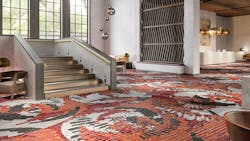How Durkan’s New Collection Preserves Centuries of Design Tradition
Crafted Convergence draws on materials as varied as everyday garments from Japan and Africa to traditional Native American pottery and baskets. However, rather than directly lifting the motifs for profit, Durkan honors the original creations by creating new, modern designs that celebrate their influences.
“I do think we’re more sensitive to the fact that you can’t just take a native African fabric, translate it into a carpet pattern and call it yours. The collection speaks to that in a sense,” explains Elizabeth Bonner, creative design director for Durkan and the lead designer on Crafted Convergence. “It’s the idea that you can draw inspiration from these things and make them your own because they’re going to have a contemporary signature on them. None of the things we produced in the collection were replicas of what we saw – they’re parts and pieces of different items that we melded together.”
Cultural Appreciation, Not Appropriation
Crafted Convergence grew out of a collaboration with the Museum of Indian Arts and Culture and the Museum of International Folk Art, two of the four museums that make up the Museum of New Mexico system. The Museum of Indian Arts and Culture focuses on preserving the culture of local Native American peoples, especially the Pueblo, Navajo and Apache communities who still live in the Southwest today. The Museum of International Folk Art features traditional arts from more than 100 countries.
A licensing program awards the museum system a royalty from sales of Crafted Convergence. The funding is used for acquisitions, exhibits and educational initiatives. In other words, the collection inspired by centuries of tradition directly supports the survival of those traditions by funding cultural facilities dedicated to teaching people about them.
“We work hard to make sure that our manufacturers go to the trouble to learn about the material, educate the consumer about the product and give credit to the culture where the designs came from,” explains Pamela Kelly, vice president of licensing and brand management for the Museum of New Mexico Foundation. “Why not try to do as much as we can to give credit back to the design resource and the people whose tradition this is?”
Inside the Collections
The first Crafted Convergence collection features strong blacks and whites and creative use of positive and negative space, drawing its most predominant inspiration from Native American pottery. The second, which was influenced by the folk-art collections, will feature bold colors and textures that echo hand-stitching and traditional quilting techniques.
The folk-art inspiration of Crafted Convergence’s second collection dovetails with Durkan and Mohawk’s own efforts to reuse scrap material from manufacturing and repurpose them into new products, Bonner explains. This scrap art theme will help introduce Crafted Convergence at this year’s HD Expo.
“Folk art was kind of the original scrap culture, the first people who were using scrap items to make something else,” Bonner explains. “Taking bits of whatever’s left over and making a piece of art out of them. We’ve got some really interesting stuff cooking and I’m excited to get to show it.”
► Design News | New Texas STEM School Honors NASA Legend
Keep scrolling to see some of the original art used to inspire the Crafted Convergence collection
Right: Seed Jar. Acoma Pueblo, New Mexico. c. 1996, Museum of Indian Arts & Culture, Santa Fe
Right: Bowl. G. Cerno. Acoma Pueblo, New Mexico. c. 1990, Museum of Indian Arts & Culture, Santa Fe
More Reading: Between Craft and Industry
About the Author
Janelle Penny
Editor-in-Chief, BUILDINGS
Janelle Penny is a senior writer for i+s and is Editor-in-Chief of BUILDINGS. She has more than a decade of experience in journalism, with a special emphasis on covering facilities. She aims to deliver practical, actionable content for her readers.

